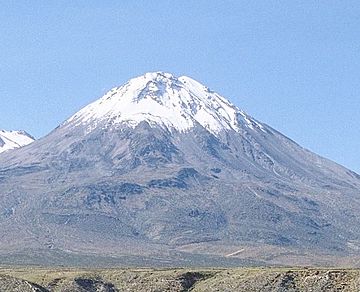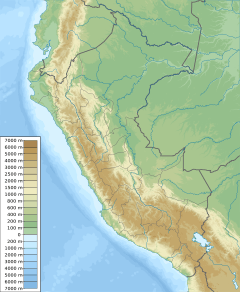Yucamane facts for kids
Quick facts for kids Yucamane |
|
|---|---|
| Yucamani | |

Yucamane as seen from the southwest.
|
|
| Highest point | |
| Geography | |
| Location | Peru, Tacna Region |
| Geology | |
| Mountain type | Stratovolcanoes |
| Last eruption | 1,320 BCE |
Yucamane, also known as Yucamani or Yucumane, is a type of volcano called a stratovolcano in southern Peru. It is made mostly of a rock called andesite.
Yucamane is part of a chain of volcanoes in the Andes mountains. This chain is formed because the Nazca Plate is sliding under the South American Plate. Other active volcanoes in Peru, like Ubinas, Sabancaya, and El Misti, are also part of this same volcanic chain.
Yucamane, along with two other volcanoes named Yucamane Chico and Calientes, formed a long time ago. Yucamane is built mostly from lava flows (melted rock that flows out) and some pyroclastic rock (rock pieces thrown out by an eruption). It has a clear summit crater (a bowl-shaped opening at the top) that still shows some fumarole activity (steam and gas coming out).
This group of volcanoes was active many thousands of years ago. Yucamane itself had several big eruptions, and Calientes had lava flows. The last known eruption of Yucamane happened around 1,320 BCE (Before Common Era). It is not clear if there were eruptions more recently, as some might have been from a different volcano called Tutupaca.
Contents
Where is Yucamane Located?
Yucamane is found in the Tacna Region of Peru. It is west of Lake Vilacota. The town of Candarave is about 7 to 11 kilometers (4 to 7 miles) southwest of the volcano. The city of Tacna is about 90 kilometers (56 miles) to the south.
Many small farming towns are on the slopes of Yucamane. These include Aricota, Cairani, and Tarata. There are also irrigation systems and main roads nearby. In the past, people used to mine for sulfur on the volcano.
You can reach the Yucamane area by several roads. One of these is the international highway that connects Ilo and Desaguadero. There is also a road that goes up the side of Yucamane. The volcano and the area around it are part of the Vilacota-Maure protected area.
The Andes Mountains and Peruvian Volcanoes
The Andes are the longest mountain range in the world. They stretch for about 9,000 kilometers (5,600 miles) across South America. In southern Peru, the Andes have high mountain chains, some reaching 4,000 to 5,000 meters (13,000 to 16,000 feet) high.
More than 2,000 volcanoes are in the Andes. Most are in countries like Peru, Chile, and Argentina. In Peru, seven volcanoes have been active since the Spanish arrived. However, it's hard to track volcanic activity because many areas are remote.
Yucamane is part of the Central Volcanic Zone. This is one of the three main volcanic belts in the Andes. In Peru, there are about 400 old, worn-down volcanoes. There are also active ones like El Misti, Sabancaya, and Ubinas. Some volcanoes, including Yucamane, might have been active in recent history.
The biggest eruption in Peru happened in 1600 at Huaynaputina. It caused 1,500 deaths and a lot of damage. Other large eruptions happened at El Misti, Ubinas, and Tutupaca. Some volcanoes like Ampato and Coropuna are very tall, over 6,000 meters (20,000 feet) high.
What Yucamane Looks Like
Yucamane is a tall mountain, about 5,495 to 5,508 meters (18,028 to 18,071 feet) high. It is a compound volcano, meaning it's made of many layers of lava and ash. It has a large summit crater that is about 800 meters (2,600 feet) wide. Inside this big crater, there is a smaller one, about 300 meters (980 feet) wide and 120 meters (390 feet) deep.
The top of the volcano looks new. Because the volcano is relatively young, there are not many signs of glaciation (being covered by glaciers). Yucamane has a cone shape. It is mostly made of lava flows, which are 20 to 50 meters (66 to 164 feet) thick. These flows often have ridges.
The upper western and southern sides of the volcano have many lava flows. The eastern and far southern sides have more pyroclastic flows (fast-moving currents of hot gas and rock). Scientists have noticed that the lower part of the volcano, called "Yucamane I," has gentler slopes. The upper part, "Yucamane II," has steeper slopes. The lower part shows signs of being covered by glaciers in the past.
Other volcanoes are north of Yucamane. These include Yucamane Chico and Calientes. They form a volcanic chain about 11 kilometers (7 miles) long. Calientes and Yucamane are considered a pair of volcanoes. Other volcanoes in the area are San Pedro and López Extraña.
Water Around Yucamane
The water from the volcano's slopes flows west, east, and south. It goes into the Calientes and Callazas rivers. Both rivers flow south and eventually join to form the Locumba river, which flows into the Pacific Ocean.
The water in these rivers has a lot of arsenic. This arsenic comes from the volcanic rocks, including those from Yucamane. Arsenic in drinking water can be harmful, so the water needs to be treated.
How Yucamane Formed
Off the western coast of South America, the Nazca Plate is slowly sliding under the South America Plate. This process is called subduction. It happens at a speed of about 4.6 centimeters (1.8 inches) per year. This subduction is why there are so many volcanoes in the Andes.
When the Nazca plate slides down, it releases fluids. These fluids cause rocks to melt, forming magma. This magma then rises to the surface and erupts as volcanoes. The subduction process is not the same everywhere. Volcanic activity is strongest where the plate slides down at a steep angle.
Volcanoes have been active in this region for a very long time, since the Jurassic period. During the Miocene epoch, volcanoes were active all over Peru. But in more recent times, during the Pliocene and Pleistocene epochs, volcanic activity has been mainly in southern Peru.
Yucamane sits on older rock layers. These layers include ancient lavas and sediments. Beneath Yucamane, there seems to be a large, ring-shaped area where magma pushed up into the crust.
What Yucamane Rocks Are Made Of
Yucamane has erupted different types of rocks. These include andesite, basaltic andesite, and dacite. Andesite makes up most of the volcano. These rocks contain small crystals of minerals like plagioclase and hornblende.
The magma that formed these rocks likely came from a mix of melted crustal material and changes in the magma deep underground.
Climate and Nature Around Yucamane
The area around Yucamane has a dry tropical climate. Yucamane gets about 180 to 200 millimeters (7 to 8 inches) of rain each year. Most of this rain falls during the summer months. The amount of rain decreases closer to the coast. After it rains, the mountain is sometimes covered with snow. Because there isn't much rain, the volcanoes are not very worn down by erosion.
Above 4,500 meters (14,760 feet), temperatures are almost always freezing. Between 3,800 and 4,500 meters (12,470 and 14,760 feet), daytime temperatures can reach 5°C (41°F), but it usually freezes at night.
The plants around the volcano vary. On the upper slopes, there is a humid tundra with not much vegetation. On the lower slopes, there is paramo (a type of grassland) and montane steppe (dry grassland). Some Quenoa trees have been seen on the slopes. The volcano is part of the Vilacota Maure Regional Conservation Area.
A type of scorpion called Brachistosternus ninapo is named after the volcano. The word ninapo comes from a local language and means "fire-spitting mountain." This scorpion was found on the sides of Yucamane and El Misti volcanoes.
History of Eruptions
Scientists have studied the rocks around Yucamane to learn about its past eruptions. Yucamane Chico and Nazaparco volcanoes erupted millions of years ago. Yucamane itself had lava flows around 380,000, 23,000, 7,100, and 3,000 years ago. The activity of Calientes and Yucamane happened at similar times.
About 44,000 years ago, there was an eruption. Another one happened about 36,450 years ago. This eruption caused a "lateral blast" that sent rock and ash down the western and southern sides. Another event around 3,270 years ago expelled a lot of material, including pumice and volcanic ash. This eruption was very powerful.
During the last ice age and more recently, Yucamane had several explosive eruptions. These eruptions produced ash falls, block and ash flows, and pyroclastic flows. In total, about 4 to 5 large explosive eruptions happened after the last ice age.
Recent Volcanic Activity
Some old reports mention eruptions in 1787, 1802, 1862, and 1902. These might have been from Yucamane, but some could have been from Tutupaca. The 1787 and 1902 events involved ash coming out. However, scientists have not found any volcanic material from Yucamane that is newer than the eruption from about 3,270 years ago. The Global Volcanism Program says the most recent confirmed eruption was in 1,320 BCE.
Today, Yucamane has fumaroles (small vents releasing steam and gases) in its summit crater. These are easier to see after it rains. Yucamane is currently considered a dormant volcano, meaning it is not erupting but could in the future. Satellites have seen small temperature changes on Yucamane, but their cause is not clear. There is also a geothermal area nearby with geysers and hot springs, but it seems unrelated to Yucamane itself.
Volcanic Dangers
As of 2021, scientists are watching Yucamane closely. They use seismometers (to detect earthquakes), tilt detectors, and cameras. The Peruvian geological agency, INGEMMET, says Yucamane is a "moderately hazardous" volcano.
They have made maps that show where ash fall, lava flows, and pyroclastic flows could go. Lava flows could threaten the western, eastern, and southern sides of the volcano. Lava flows can bury land and start fires. They can also block rivers, which might cause floods later. Pyroclastic flows are very fast and hot, and they can cause suffocation, burial, and burns. More than 9,000 people live in the danger zone around Yucamane.
Ash from an eruption could travel southeast towards the border with Chile. It could affect towns like Candarave, Ilabaya, and Tarata. Volcanic earthquakes and volcanic gases are also dangers.
See also
 In Spanish: Yucamani para niños
In Spanish: Yucamani para niños
- Chiarjaque
- Choreveco


